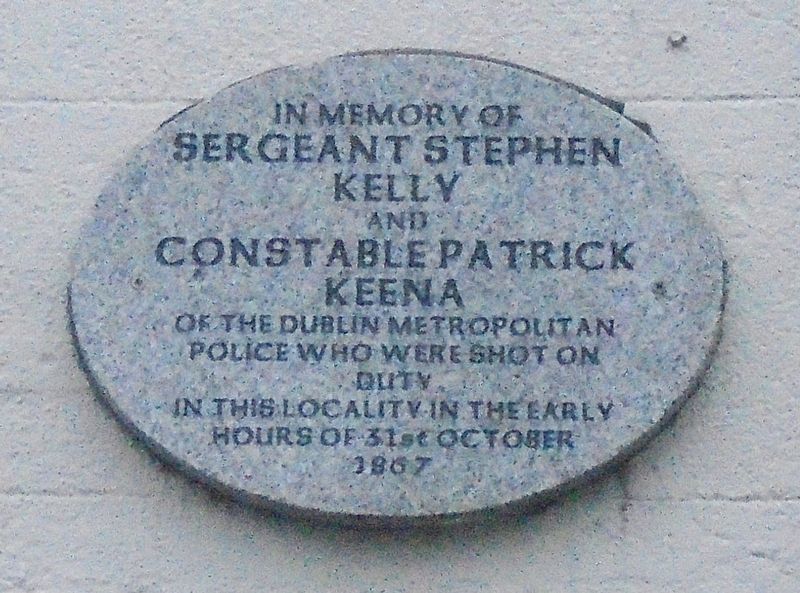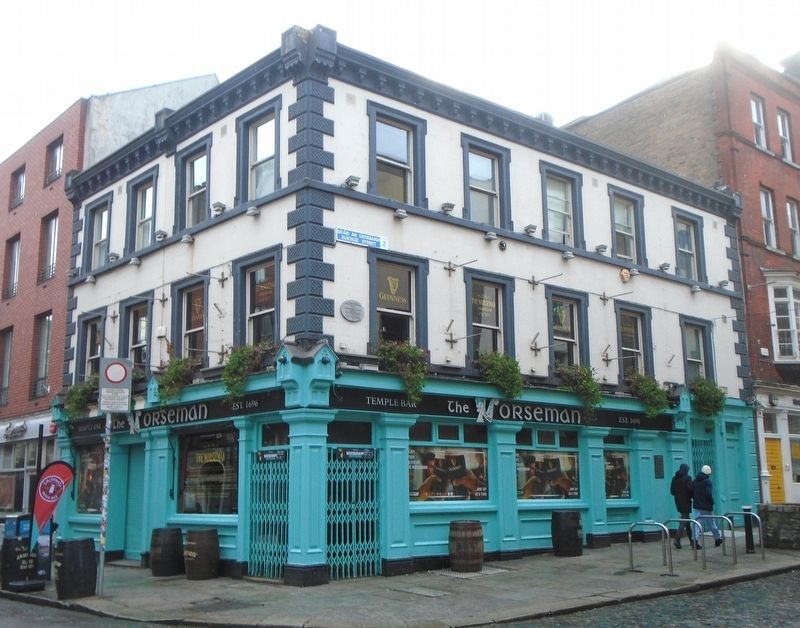Temple Bar in Dublin in County Dublin, Leinster, Ireland — Mid-East (and Dublin)
Sergeant Stephen Kelly and Constable Patrick Keena
In Memory of
Inscription.
Dublin Metropolitan Police
who were shot on duty in this
locality in the early hours
of 31st October 1867
Erected 2010.
Topics. This historical marker is listed in this topic list: Law Enforcement. A significant historical date for this entry is October 31, 1867.
Location. 53° 20.724′ N, 6° 15.888′ W. Marker is in Dublin, Leinster, in County Dublin. It is in Temple Bar. Marker is at the intersection of Essex Street East and Eustace Street, on the right when traveling east on Essex Street East. Touch for map. Marker is at or near this postal address: 28E Essex Street East, Dublin, Leinster D02 F729, Ireland. Touch for directions.
Other nearby markers. At least 8 other markers are within walking distance of this marker. The Norseman (here, next to this marker); St. Winifred's Well (a few steps from this marker); Sir William Temple (within shouting distance of this marker); Frederick Douglass (about 90 meters away, measured in a direct line); Liffey Bridge (about 150 meters away); Castle Hall (approx. 0.3 kilometers away); First Performance of Handel's Messiah (approx. 0.3 kilometers away); The Beatles (approx. 0.4 kilometers away). Touch for a list and map of all markers in Dublin.
Regarding Sergeant Stephen Kelly and Constable Patrick Keena.
Excerpt from "Shot Mullingar policeman honoured on new Dublin plaque" (Westmeath Examiner, 29 Sep 2010):
A commemorative plaque was recently unveiled at Farrington’s, East Essex Street by Dublin Lord Mayor, Gerry Breen to mark the launch of “Shadow of the Brotherhood: The Temple Bar Shootings” - a new true crime story written by Meath author Barry Kennerk and published by Mercier Press. The plaque honours the memories of two unarmed members of the Dublin Metropolitan Police who were shot in the locality on a foggy, gas-lit night on 31 October 1867. The youngest man was a 24-year-old Mullingar Constable named Patrick Keena. The second was Sergeant Stephen Kelly (aged 35) from Monasterevin.
Both were shot by a Fenian splinter group - a squad that was responsible for twelve high-profile shootings between 1866 and 1871. The story is a tragic one, Mr. Kennerk told the Westmeath Examiner this week, as he spoke of young Keena, who came from the Ballyglass area of town. “(Patrick) was the sole supporter of his parents and his sister,” Mr. Kennerk found. The funeral for Constable Keena was massive: “In the mourning coach were his parents, his sister, and an aunt, and the cortege was so long that as they bottom was coming over O’Connell Bridge, the top was still turning into Parnell Square,” says Mr. Kennerk, adding that there was a large presence of mounted officers present for the funeral. “There were
so few officers left to police the streets that they had to bring in reserve officers. “They brought the hearse up to Broadstone, and from there then to Mullingar, and there was a great report in the Westmeath Guardian that gives an account of the funeral itself.” The funeral coincided with an annual two-day fair in Mullingar, and it took place on Sunday November 10 1867, the Feast of the Blessed Virgin.
Somewhat surprisingly, Constable Keena was buried at the Church of Ireland cemetery at Lynn, Mullingar, although the family lived at Ballyglass. That said, there was no cemetery at Ballyglass at that time. “I have traced the family back to Lynn: they lived there in the 1840s,” says Mr. Kennerk, adding that the young constable’s father, John, was a member of the Tenant Rights’ Association. “When they arrived at the cemetery gates, it was a real foggy evening, and the mother hadn’t seen her son’s face, because she hadn’t gone up to the hospital when he was dying, so she persuaded the people with the coffin to let her see him, and it was opened in candlelight.” Mr. Kennerk, who came to Mullingar several times as he put the story together, was disappointed not to be able to identify Constable Kelly’s grave at Lynn, although he was delighted when he did, eventually, find the graveyard itself. The killing of Constable Keena and Sergeant Kelly attracted major attention at the time, and in fact, the then Lord Mayor of Dublin raised funds for the families of the two deceased man.
Credits. This page was last revised on February 7, 2024. It was originally submitted on February 7, 2024, by William Fischer, Jr. of Scranton, Pennsylvania. This page has been viewed 48 times since then. Photos: 1, 2. submitted on February 7, 2024, by William Fischer, Jr. of Scranton, Pennsylvania.

